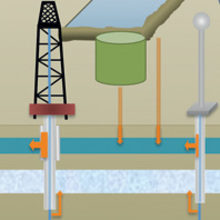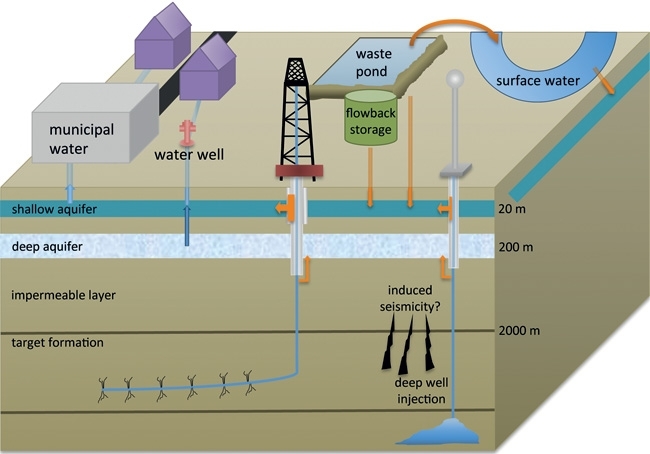Comment: Hydraulic fracturing - what do microbes have to do with it?
17 November 2014

Hydraulic fracturing, or fracking, is a hot topic. The process injects high-pressure fluid horizontally into deep wells to fracture impermeable rocks releasing pockets of trapped oil and gas. It has transformed the USA natural gas industry, with shale skyrocketing from 4% of total natural gas production in 2005 to 23% in 2010. With abundant shale gas reserves all over the globe, it is no surprise that other countries are eager to frack on their own soil.
The USA has served as a global test bed for hydraulic fracturing. In Pennsylvania, for example, over 6,000 unconventional natural gas wells have tapped into the underlying Marcellus Shale. Large-scale fracking now spreads across the country to states such as Utah, Wyoming and California. The dizzying pace of development has raised public concerns that the risks and impacts to water quality beyond obvious accidents and spills are not well known. To compound the problem, natural gas development is occurring close to people’s homes, sometimes literally in their backyards.
Microbes play a critical role in groundwater quality; pollutants can alter the composition of groundwater microbial communities. In fact, their sensitivity to pollutants may allow them to be useful for monitoring contamination from fracking activities. Currently, little is known about the risks to groundwater from fracking, and even less about the effects on groundwater microbiota. This is due at least in part to a lack of baseline data for comparison, meaning that great research opportunities exist to learn about the microbes that live in the subsurface and how they respond to fracking contamination.
Two important avenues exist for fracking to contaminate groundwater. The first involves the fluids used for and produced by hydraulic fracturing. The most likely mode of contamination arises from spills and leakages on the surface while the well is fracked or during transport and storage, which primarily affect surface and shallow groundwater. Fluids could also enter groundwater through faulty well casings. There are three chemically and biologically distinct types of fluids: fracking fluid, flowback and produced water.

Fracking fluid is injected into the well under high pressure to fracture rock so that the oil and/or gas can be extracted. Of the hundreds of known chemicals used for fracking, many are added to control microbial growth, and include biocides (e.g. glutaraldehyde), acids and oxygen scavengers. In the USA, the requirements for disclosing the chemicals used for fracking vary by state, and public disclosure is sometimes voluntary. Moreover, companies are not required to disclose the composition of proprietary chemicals, so-called ‘trade secrets’. Complete public disclosure of these chemicals would allow us to study their effects. A useful (albeit incomplete) database of the chemicals used in USA fracking operations is available at FracFocus.org
After fracking occurs, the higher pressure within the well forces some of the fracking fluid out, and this is referred to as flowback. Flowback typically is generated for a few weeks after fracking. This wastewater contains high levels of dissolved solids, salts and fracking chemicals, and must be stored and treated or reused. Up to 70% of the injected fluid is not recovered, and its fate in the subsurface is unclear. When the flowback runs out, fluid that exists within the oil or gas-producing formation, called produced (or formation) waters, can be recovered. These fluids are very salty and can contain harmful levels of metals and radioactivity.
We are beginning to understand the succession of microbiota in the fluids used for and produced from fracking. Despite best efforts to prevent growth, microbes survive in fracking fluids and likely take advantage of the energy sources added to fracking fluid. Fracking fluid selects for taxa that can survive the biocide, and the survivors can grow on the ample nutrients in the fracking additives. Salinity becomes an important driver of community-level changes as energy sources run out and formation waters mix with the fracking fluid. Salt-tolerant, fermenting organisms such as Halolactibacillus dominate in the initial flowback and may continue to consume the organic carbon sources within the fracking fluids. Flowback is sometimes used again to frack other wells, and likely enriches for salt-tolerant, biocide-resistant organisms. Once oxygen and energy sources are depleted, anaerobic and salt-tolerant members of the Firmicutes such as Halanaerobium comprise the vast majority of the microbiota found in produced water. At this stage, it is thought that the microbiota originate from the target formation. The composition and succession of these microbiota may allow us to trace the timing and sources of groundwater contamination from fluids produced during hydraulic fracturing.
The second mode of contamination comes from stray gas migration. Numerous recent studies suggest that natural gas migrated into groundwater as a result of fracking activity. These studies found thermogenic methane in the groundwater, or methane that originated from the target formation. This methane is generated abiotically under high temperatures and pressures. While finding thermogenic methane in groundwater clearly connects deeper subsurface processes with the shallow subsurface, some groundwater systems are ‘leaky’ and can contain thermogenic methane naturally. Without a doubt, the provenance of methane only provides part of the story, and reinforces the need for multiple lines of evidence.
Microbes may provide another line of evidence, and I am currently working to evaluate the potential for microbiota to predict groundwater geochemistry. During the summer of 2013, a sampling campaign was conducted to characterise the microbiology of groundwater in the Denver-Julesberg Basin of Colorado, which has undergone rapid shale gas development. A large research programme recently established to quantify the environmental, economic, and societal impacts of fracking in the Rocky Mountain region is already yielding promising results. I collaborated with their research team to characterise the microbiology of groundwater from private wells in close proximity to fracking activity and relate it to geochemical data. Even from this relatively small study, we have gleaned valuable insights about the microbiota, including differences between shallow and deep groundwater and possible indicators of in situ methane production. The next step is conducting targeted experiments in order to establish links between fracking activity and groundwater microbiology.
The microbiology of groundwater is clearly complex, and our knowledge of how extraction activity influences the microbiota is still in its infancy. Still, there is real potential in using microbes to monitor fracking contamination. With continued research, appropriate regulations, and careful monitoring, we can ensure the responsible development of this vast energy resource.
LEE STANISH
University of Colorado, UCB 347, Boulder, CO 80309, USA
[email protected]
Further reading
Information on the Rocky Mountain project can be found at AirWaterGas.org
An updated list of scientific articles and other resources related to fracking are on Lee’s blog.


